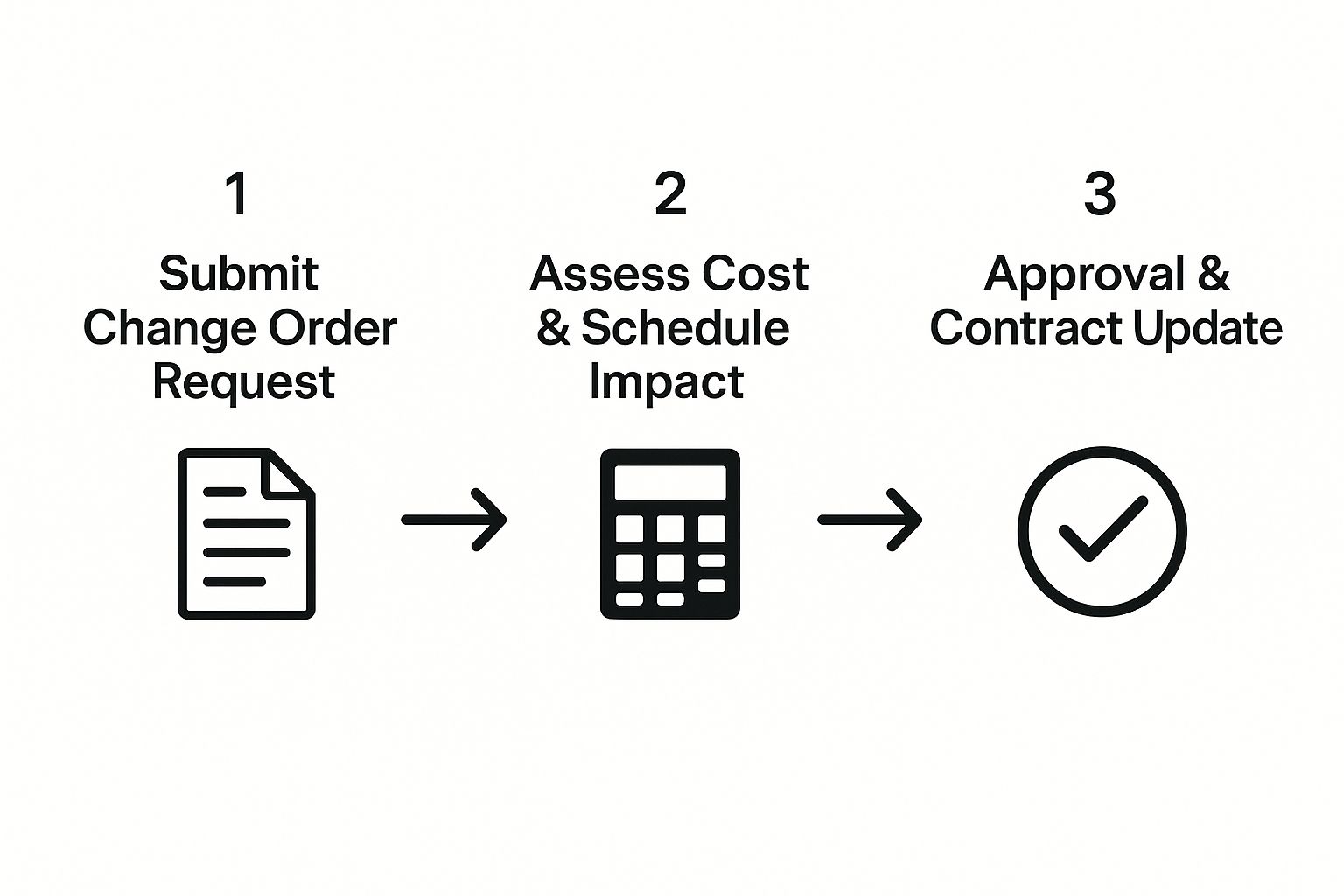A construction change order is the formal, documented process for any deviation from a project's original contract. It's the essential framework that keeps contractors, clients, and architects aligned when the scope, cost, or timeline needs to adjust. This process ensures all parties in a Bay Area construction project are protected and on the same page.
Why Construction Change Orders Are Unavoidable

It’s a common myth that change orders only happen because of poor planning. The reality is they’re a natural and often necessary part of almost every construction project. The smoothest projects are those where everyone accepts this from day one.
Viewing change orders as a structured way to manage project evolution is key to better communication and fewer headaches. From a simple material swap to a major design pivot, these documents create a clear, agreed-upon path forward. This is especially true here in the dynamic Bay Area construction scene, where adapting on the fly is part of the job for builders, architects, and homeowners alike.
Common Triggers for Change Orders in Bay Area Projects
Change orders can be triggered by many factors, from discoveries behind old walls to new ideas from the client. Here’s a quick look at the most common reasons we see them pop up on projects across Berkeley, Oakland, and San Francisco.
| Trigger Category | Specific Example | Primary Impact |
|---|---|---|
| Unforeseen Site Conditions | Discovering dry rot in a Berkeley Victorian or hitting unexpected rock during excavation in the San Francisco hills. | Budget and schedule increase to address the issue. |
| Owner-Driven Changes | A client sees a neighbor's remodel and decides to upgrade from standard windows to premium Andersen models. | Scope and budget increase; potential timeline adjustment. |
| Architectural Refinements | An architect tweaks a design detail mid-project to improve flow or aesthetics after seeing the space framed out. | Minor cost and schedule adjustments for rework. |
| Code & Regulatory Updates | A local building code is updated mid-project, requiring changes to electrical or plumbing plans. | Scope, budget, and timeline increase to meet compliance. |
Understanding these common scenarios helps set realistic expectations for everyone involved. This makes the entire process much less stressful when a change inevitably occurs.
Unforeseen Site Conditions
No matter how thoroughly you inspect a site, some issues don't appear until you start opening walls or digging. This is particularly true for remodels in historic Berkeley or Oakland neighborhoods.
You might encounter:
- Hidden structural issues: Finding extensive termite damage or dry rot behind a wall that looked perfectly fine.
- Geotechnical surprises: Hitting a massive boulder or unstable soil during excavation for a new foundation.
- Outdated systems: Discovering old knob-and-tube wiring that must be replaced to meet modern building codes.
These are not anyone's "fault," but realities of construction. A formal change order is the professional way to pause, document the issue, and agree on the new scope and budget needed to fix it.
Owner and Architect-Driven Changes
A project's vision can, and often does, evolve during construction. A homeowner might decide they want to add a skylight after seeing how natural light fills a room. An architect might refine a detail to improve the home's functionality or aesthetics.
A change order isn't a failure; it’s a tool for flexibility. It allows a project to adapt to new ideas or improved solutions, ensuring the final result truly meets the client’s vision without creating financial or legal ambiguity for the builder.
These client-driven modifications are a major source of change orders. The key is to have a process that welcomes these ideas while ensuring you're compensated for the extra work and materials. This is where having a reliable partner like a professional builders supply store is a lifesaver for sourcing new materials without derailing the schedule.
The Financial Impact of Change Orders
The need for a solid change order process isn't just anecdotal; the data backs it up. A global study from Turner & Townsend revealed that change orders can account for up to 10.6% of the total cost on smaller commercial projects. On larger ones, that figure is 8.4%.
Those percentages translate directly into bigger bills and longer timelines. A well-managed change order system isn't just paperwork—it’s professional risk management. It protects contractors in Berkeley, homeowners in Oakland, and architects across the Bay Area by creating a transparent record of every decision that alters the original agreement.
How to Define the Change Order Process in Your Contract
Your best defense against change order chaos isn't fancy software—it's a crystal-clear contract clause. This pre-negotiated agreement turns a potential argument into a simple, documented procedure. For any builder in Berkeley or remodeler in Oakland, a rock-solid contract is the foundation of a smooth project.
This foresight protects both you and your client from headaches down the road. It establishes a framework for changes upfront, building a foundation of trust and professionalism from day one.
What Goes into a Change Order Request?
Your contract must be specific and leave no room for interpretation. It should spell out that a formal Change Order Request (COR) must be in writing—no exceptions.
This written request should always include, at a minimum:
- A clear description of the proposed change to the scope of work.
- References to the specific plans or contract sections being altered.
- An initial breakdown of the expected costs for both materials and labor.
- An estimate of how the change will impact the project schedule.
Requiring a standard, written format forces everyone to think through the details. It moves the conversation from a casual chat on-site to a formal process where every change is properly captured and tracked.
Set Firm Deadlines for Submission and Approval
Vague timelines are a recipe for friction and delays. Your contract must establish a clear, reasonable timeframe for submitting a COR and for the client to review and approve it. Without deadlines, a pending change can bring progress to a grinding halt.
For example, a clause could state the client has five to seven business days to respond to a submitted COR. This prevents a critical decision from sitting in an inbox for weeks while material prices climb. It creates shared urgency and respect for the project's momentum.
By defining the timeline for review and approval in the contract, you replace uncertainty with a predictable rhythm. This is one of the most effective ways to keep a project on track and stop small delays from snowballing into major problems.
Who Has the Authority to Approve?
On any project, especially one with a homeowner, architect, and designer, you must know who gets the final say. Your contract must explicitly name the person (or people) with the authority to approve a change order. This is non-negotiable.
This detail protects you from incurring costs based on direction from someone who can't legally authorize the spending. Nailing this down ensures the signed change order becomes a binding part of the contract, a critical detail for projects across San Francisco and the wider Bay Area.
Agree on How Costs Are Calculated
Finally, your contract must spell out exactly how the cost of extra work will be calculated. This transparency is essential for maintaining client trust. The two most common approaches are Lump Sum and Time and Materials (T&M).
- Lump Sum: This is a single, fixed price for the entire change, covering all labor, materials, and markup. It gives the client cost certainty.
- Time and Materials (T&M): Here, you bill for the actual cost of labor (at a pre-agreed rate) and materials, plus a set percentage for overhead and profit. This is ideal when the full scope of a change is difficult to determine upfront.
Defining the calculation method in the contract means no ugly surprises when the bill arrives. Everyone agrees on a fair system before work starts, cementing a professional construction change order process.
Creating a Clear and Defensible Change Order Request
When a change is unavoidable, the quality of your paperwork separates a smooth approval from a project-stalling dispute. A well-crafted Change Order Request (COR) is a critical tool for professional, transparent communication. Nailing this document is key to getting paid fairly and keeping your client’s trust.
This ensures everyone—from the homeowner in Oakland to the architect in San Francisco—knows what's changing, why, and what the impacts will be. It elevates the conversation from a casual "hey, can we…?" to a formal, documented agreement.

A successful change order follows a clear path from request to formal approval. Each step builds on the last, which is why starting with solid documentation is so crucial for a smooth assessment and final agreement.
Detailing the What and Why
The heart of any strong COR is a rock-solid description of the change. Vague notes like "fix unforeseen issue" are a recipe for conflict. Be specific and tie your language directly to the original contract documents.
For example, instead of "install different windows," write: "Substitute Andersen 400 Series casement windows (Model #XXX) for the originally specified windows on the south elevation, as shown on drawing A-4. This change is required to meet the client's new request for improved solar heat gain control." This detail leaves no room for misinterpretation.
Justifying the Costs Transparently
The financial breakdown is the part of the construction change order process that gets the most scrutiny. Transparency is non-negotiable. Your COR needs an itemized list of every associated cost.
Your cost breakdown must always include:
- Material Costs: List specific materials, quantities, and their prices. Mentioning your source—like getting a quote for new Marvin windows from Truitt & White in Berkeley—adds local credibility.
- Labor Costs: Break down the number of labor hours needed and the hourly rate defined in your contract.
- Equipment Costs: If you need to bring in new equipment, list the rental or operational costs clearly.
- Markup: State your contractual overhead and profit percentage. This should never be a surprise to the client.
Assessing the Schedule Impact
In construction, time is money. Any delay can create a domino effect. Your COR must include an honest, realistic assessment of how the proposed change will impact the overall project schedule.
A well-crafted change order isn’t just about getting paid for extra work; it's about resetting expectations. Clearly communicating schedule impacts upfront prevents future arguments about project delays and demonstrates your professionalism as a project manager.
If swapping a standard door for a custom-ordered one adds four weeks to the timeline due to manufacturing lead times, state that clearly. This gives the owner the information needed to make an informed decision. Downplaying schedule impacts will only damage your credibility. For more tips, review our general construction questions and answers.
Securing Approval Without Straining Relationships

You’ve prepared a detailed, transparent, and fair Change Order Request (COR). Now comes the most delicate part: getting the signature. This stage is less about paperwork and more about people, hinging on clear communication and trust.
How you present a change order makes all the difference. Walk the client or architect through the "why," explain the impacts logically, and show you're their partner in achieving the best result. For builders in Berkeley and remodelers in Oakland, mastering this conversation is a mark of true professionalism.
Presenting the Change with Confidence and Clarity
Always frame the COR as a collaborative solution, not a problem with a price tag. Schedule a quick meeting or call to walk through the document together. A personal touch goes a long way.
Explain the situation clearly. For instance: “During framing, we saw an opportunity to improve the kitchen layout, but it means rerouting this plumbing line. The change order I sent over breaks down the exact cost and the two extra days needed.” This approach frames the change as a project enhancement.
This formal process is critical as projects grow more complex. With global infrastructure spending projected to jump by 9.4% in 2025, well-managed approvals are non-negotiable. You can read the full S&P Global Market Intelligence research to see how these trends are shaping our industry.
Navigating Negotiations and Common Hurdles
Expect some negotiation—it’s a normal part of the process. A client might question the cost, necessity, or schedule impact. Don't take it personally. Your detailed documentation is your best friend here.
If a client pushes back on price, calmly walk them through your material quotes and labor estimates again. If they question the need, refer back to the specific site conditions or request that triggered the change.
The Golden Rule of Change Orders: Never, ever start work on a change without a signed approval. Proceeding on a verbal "okay" is one of the biggest financial risks a contractor can take and a fast track to payment disputes.
This rule is absolute. A signature transforms the request into a legally binding part of your contract. Many successful Oakland contractors we partner with have told us this principle is a cornerstone of their business.
Integrating the Approved Change
Once you have the signature, the job isn't done. The final step is to formally integrate the change into your project management system. This means updating the project's DNA so everyone is on the same page.
Change Order Approval Status and Next Steps
| Approval Status | Client Action | Contractor's Next Step |
|---|---|---|
| Approved | Signs the COR, confirming agreement on scope, cost, and schedule. | Update the master schedule, order new materials, and brief the crew on the new scope of work. |
| Pending | Requests more information or wants to negotiate terms. | Provide requested details promptly and engage in professional negotiation to reach an agreement. |
| Rejected | Declines the change order, accepting that the original plan will proceed. | Formally document the rejection and continue work based on the original contract documents. |
Properly tracking and integrating an approved change ensures the new scope is seamlessly absorbed into the workflow. It prevents confusion and keeps your entire team and client aligned.
Proactive Strategies to Minimize Disputes and Delays
The best change order is one you never have to write. While some changes are part of the job, a proactive approach can turn the construction change order process from a headache into a sign of professionalism. For any contractor in the competitive Bay Area market, getting this right protects your bottom line and keeps clients happy.
The goal isn't just reacting to changes faster; it's building a process where fewer disputes happen. This comes down to solid communication, diligent documentation, and using the right tools to keep your projects in Oakland, Berkeley, and beyond running smoothly.
Foster Relentless Communication
Constant, clear communication is the most powerful tool for preventing disputes. Get into a regular rhythm of project updates to keep everyone—client, architect, and your crew—on the same page.
Make these habits second nature on your job sites:
- Weekly Site Meetings: Hold brief, on-site meetings to review progress and spot potential issues before they become formal problems.
- Transparent Updates: Send a quick weekly email summarizing work completed, outlining the plan for the next week, and flagging upcoming decisions.
- Document Everything: Follow up any important call or verbal agreement with a quick email confirmation to create a paper trail.
Embrace Modern Digital Tools
Relying on paper and memory alone is a recipe for disaster. Digital tools provide a single source of truth, making everything more transparent and letting you track changes with pinpoint accuracy. These systems create a rock-solid record of conversations, approvals, and timeline shifts.
By maintaining a clear, digital log of all communications, approvals, and submitted documents, you create an unshakeable foundation of fact. This documentation is your best defense against "he said, she said" arguments and ensures that every decision is traceable and transparent.
To truly avoid bottlenecks, you have to master project workflow management for the entire change order process. A holistic view helps you see potential delays long before they can derail your schedule.
Anticipate and Mitigate Material and Cost Volatility
The construction industry continues to grapple with economic pressures. Recent reports show construction cost inflation is expected to hover between 3.5% and 3.9% in major markets, with change orders being a huge part of that. Smart contractors use digital tools and smarter contract clauses to handle these changes with transparency and speed.
Be proactive about this reality. Talk to your clients about material lead times from the start, especially for custom items like windows and special-order doors from Bay Area suppliers. Discussing potential price fluctuations in initial talks reinforces your role as a trusted expert. This foresight is crucial whether you are a professional contractor or learning how to prepare for your DIY projects.
By weaving together proactive communication, modern documentation, and a forward-thinking approach to costs, you can dramatically cut down on disputes. This transforms the change order process into a structured, professional system that builds client trust and keeps your Bay Area projects profitable.
Frequently Asked Questions (FAQs) About the Change Order Process

Navigating the construction change order process is a reality on almost every job site in the Bay Area. Knowing how to handle common questions with clarity keeps projects moving and client relationships intact. Here are some of the most common questions we hear from contractors, architects, and homeowners.
What’s the difference between a change order and a construction change directive?
A standard change order is a formal amendment to the contract that all parties agree to before work begins. In contrast, a Construction Change Directive (CCD) is an order from the owner to proceed with work immediately, even without a prior agreement on cost or time. A CCD is used to prevent costly delays but carries more risk than a fully executed change order.
Can a contractor refuse to perform a change order?
Generally, a contractor must perform a change that falls within the project's original scope. However, contractors can refuse a "cardinal change"—a modification so significant it completely alters the project, like adding a second story to a kitchen remodel. Your contract should provide guidance on what constitutes a reasonable change.
What should I do if a client gives only a verbal approval for a change?
A verbal approval is not legally binding and puts your business at risk. If a client gives a verbal "go-ahead," immediately document it by drafting a formal Change Order Request. Politely explain that you must follow the process outlined in the contract to protect everyone and do not begin work until you have a signed document.
Who pays for a change order caused by errors in the plans?
If a change is needed due to an error or omission in the architectural or engineering plans, the project owner is typically responsible for paying the contractor for the extra work. The owner may then seek reimbursement from their design professional. As the contractor, your duty is to build to the plans, and you should be compensated for any required corrections via a formal change order.
How can I protect my business from sudden material price increases?
The best protection is an "escalation clause" in your contract. This provision defines how significant, unforeseen increases in material costs will be handled, usually through a change order. Discussing this possibility during contract negotiations, especially in a volatile market like the Bay Area, is crucial for protecting your profit margins. A similar proactive approach is detailed in our September home maintenance checklist.
Whether you’re navigating a complex change order or sourcing materials for a new build in Berkeley or Oakland, having a reliable partner makes all the difference. For expert advice on building materials, windows, and doors, the team at Truitt & White is here to help.
Visit our Berkeley showroom or connect with us today for expert advice.









